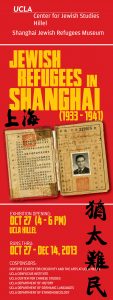From 1933 to 1941, Shanghai became a modern-day “Noah’s Ark” accepting some 18,000 Jewish refugees fleeing Nazi-occupied Europe. Most were from Germany and Austria, but the refugees also included students of the famed Mir Yeshiva, the only yeshiva in occupied Europe to survive the Holocaust. In the “Designated Area for Stateless Refugees” in Tilanqiao area of Shanghai, Jewish refugees lived harmoniously with the local Chinese, overcoming numerous difficulties together.
Conditions in the impoverished Hongkou District were harsh: 10 per room, near- starvation, disastrous sanitation and scant employment. With the aid of Iraqi Jews living in Shanghai, and later of Russian Jewish locals and the American Jewish Joint Distribution Committee, most of the Jewish refugees managed to survive and many went on to have remarkable lives. Holocaust historian David Kranzler called it the “Miracle of Shanghai.”
The exhibition, Jewish Refugees in Shanghai (1933-1941), brings together for the first time photos, personal stories and artifacts from Shanghai’s Jewish Refugee Museum, located in the former Ohel Moshe Synagogue in the Tilanqiao Historic Area. Former
“Shanghailanders” now living in Southern California also loaned memorabilia for display at the October 27th opening celebration. A satellite exhibit at UCLA’s Young Research Library features related items from the library’s collection.
This international symposium on Shanghai culture, “Cosmopolitan Shanghai,” will help to put an extraordinary exhibition in context. Speakers will explore models of cross- cultural understanding and exchanges, using the Shanghai experience prior to 1949 as a critical foundation. Panelists will focus on the music, literature, visual arts and urbanism of the 1920s, 30s and 40s and the interchange between Chinese and Western culture.
